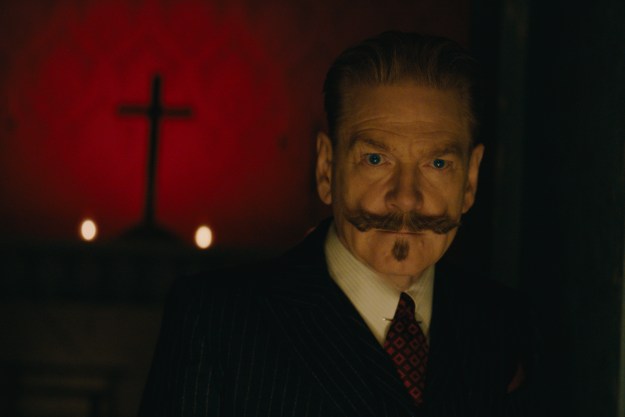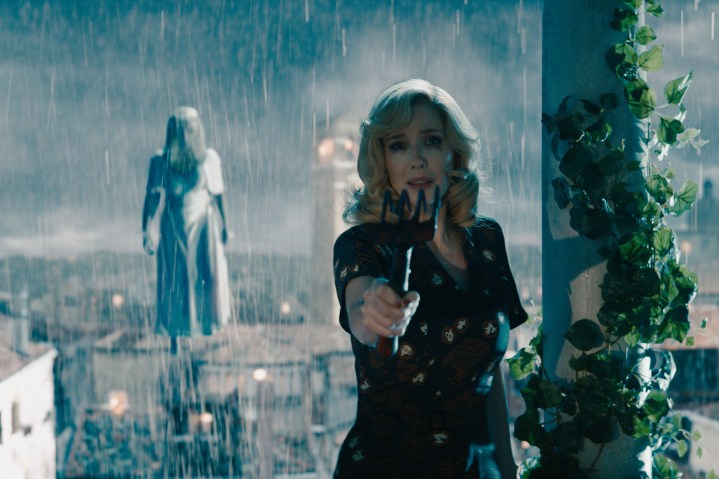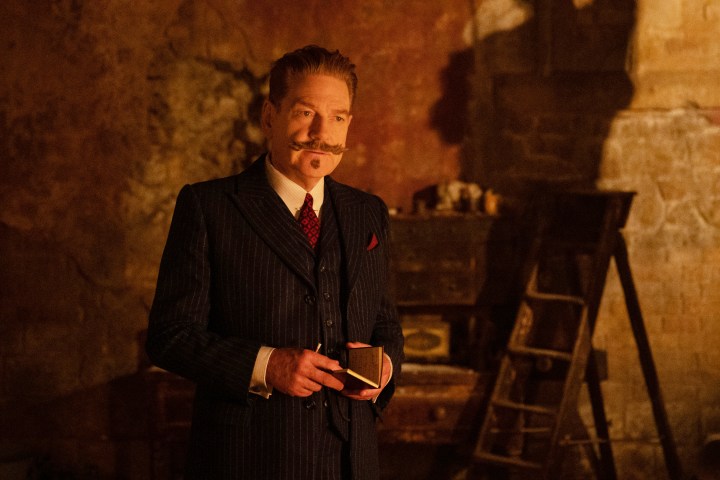
“A Haunting in Venice is director and star Kenneth Branagh's spookiest, darkest, and best Hercule Poirot adventure yet.”
- Kenneth Branagh's experimental, deliriously over-the-top direction
- Michelle Yeoh, Kelly Reilly, and Tina Fey's standout performances
- Haris Zambarloukos's alluringly dark, theatrical cinematography
- A compelling mystery
- Most characters are too broadly drawn to be memorable
- Several jarring editorial choices throughout
- A third-act resolution that's a bit too obvious
A Haunting in Venice is, above all else, a ghost story. That may come as a surprise to those familiar with director Kenneth Branagh’s previous two Agatha Christie movies (2017’s Murder on the Orient Express and 2022’s Death on the Nile). While there are plenty of murders and mysteries to be found in A Haunting in Venice, the film is primarily preoccupied with the lingering effects that death leaves on those who are forced to grieve, mourn, and go on living. In its first act, the film asks certain questions about what comes after death, and then it explores them further by increasingly blurring the lines between the material and supernatural worlds.
Ghosts continually linger and murmur beyond the edges of its frames, and while its PG-13 rating prevents A Haunting in Venice from ever going into full-blown horror territory, the mood it creates is surprisingly dark, gothic, and mournful. At the same time, there’s a formal playfulness on display throughout A Haunting in Venice that endears one to it and makes it easy to look past its flaws. It’s not only the spookiest installment of its franchise yet, but also one of the most creatively invigorating mainstream studio films that Hollywood has released this year.

Loosely based on Agatha Christie’s 1969 novel, Hallowe’en Party, A Haunting in Venice begins a decade after the events of Death on the Nile and finds its mustachioed lead, Hercule Poirot (Branagh), living a retired life in the film’s eponymous Italian city. Intent on keeping his mind off any new mysteries, Poirot has gone so far as to hire a bodyguard, Vitale Portfoglio (Riccardo Scamarcio), to fend off the many people who still hound him with their pleas for help. He is, however, pulled out of his self-imposed period of isolation by the arrival of an old friend, Ariadne Oliver (Only Murders in the Building‘s Tina Fey), a Christie-esque writer who elevated Poirot’s profile years prior when she used him as the subject of one of her books.
Ariadne requests that Poirot join her at a Halloween Night séance put on by Joyce Reynolds (American Born Chinese‘s Michelle Yeoh), a celebrity medium who has been summoned to Venice by Rowena Drake (Kelly Reilly), a former opera singer. At the latter’s request, Joyce has agreed to try and reach out to the spirit of Rowena’s teenage daughter, Alicia (Rowan Robinson), who died under mysterious circumstances at their Venetian palazzo a year prior. Rowena, perpetually lost in her own grief, hopes that Joyce’s séance will finally reveal to her the true nature of her daughter’s death.
To say much more about the film’s plot would be to spoil much of the fun of A Haunting in Venice. No Christie-inspired murder mystery would be complete without a wide array of suspects, though, and it isn’t long before Rowena’s palazzo is occupied by a full cast of potential killers and victims. In addition to Poirot, Ariadne, Vitale, Rowena, and Joyce, the séance’s attendees include Maxime Gerard (Kyle Allen), Alicia’s former fiancé; Olga Seminoff (Camille Cottin), the Drakes’ devoutly devoted housekeeper; Dr. Leslie Ferrier (Jamie Dornan), a former wartime medic plagued by PTSD; Leopold (Jude Hill), his precocious son; and Desdemona (Emma Laird) and Nicholas Holland (Ali Khan), Joyce’s refugee assistants. All of them are, as Poirot soon learns, haunted by ghosts both figurative and (potentially) literal.

A Haunting in Venice sticks close to the structure of its two predecessors. Once the film’s violent inciting incident has taken place, it spends most of its second act following Poirot as he individually interviews each of his various suspects. A Haunting in Venice’s plot, in other words, is its least interesting element, and the film’s first act suffers a bit from the sheer number of puzzle pieces that need to be put into their proper places throughout it. Branagh makes up for the familiarity of the movie’s plot and murder mystery structure, though, by delivering one of the most stylistically audacious films of his career.
Gone are the understated tracking shots and basic formalism of Murder on the Orient Express and the stale, visually grating CGI backgrounds of Death on the Nile. Using a mixture of real locations and physical sets, Branagh turns the central palazzo setting of A Haunting in Venice into his own labyrinthine haunted house. He fills out and explores the setting with a mix of sharp, extremely skewed Dutch angles, knowingly over-the-top jump scares, impressively expansive sound mixing, and, in one instance, body rig shots that jostle with every movement of the director’s body as his Poirot races to try and catch a ghost. Later, when he tries to take a break in one of Rowena’s bathrooms, Branagh places the camera in an aerial position that emphasizes the space’s cramped dimensions and makes the film’s fictional palazzo feel all the more claustrophobic and airless.
The filmmaker’s direction here isn’t just dramatic — it’s downright theatrical. Haris Zambarloukos’ cinematography, which emphasizes the film’s rich blacks and reds, evokes the expressionistic, stark black-and-white work of Gregg Toland, the famed Orson Welles and John Ford collaborator. And Branagh’s all-in, go-for-broke visual style only imbues the movie with a further kind of infectious, creatively arresting madness. Not all of the film’s stylistic flourishes work — its editing can, at times, be too jarring for its own good — but their cumulative effect is hard to deny. A Haunting in Venice, for all of its narrative and editorial flaws, moves with its own nightmarish kind of grace.

As was the case with both of Branagh’s previous Poirot movies, the characters of A Haunting in Venice are often too broadly sketched and performed to leave much of a mark. This time around, it’s Reilly, Yeoh, and Fey who emerge as the film’s standouts, delivering performances that suit their characters’ cartoonish emotional proportions. No one in this franchise is ever given as much dimension as Poirot himself, though, whom Branagh plays with a winning mix of weariness and twinkly eyed charm. Here, the actor and returning screenwriter Michael Green make Poirot’s customarily emotional response to the horrors at hand feel more palpable and justified than ever have before.
Ultimately, A Haunting in Venice is, like its two predecessors, an odd film. It’s a murder mystery that, for the most part, remains content to play by the numbers, but the ways in which it doesn’t are often startlingly effective. Rarely does a contemporary Hollywood studio release feel as stylistically free as Branagh’s latest. Does that mean it’ll leave you truly haunted? Not necessarily. But you might leave it, like this writer did, buzzing just a little.
A Haunting in Venice is now playing in theaters. For more about the movie, please read A Haunting in Venice‘s ending, explained.
Editors' Recommendations
- Murder on the Orient Express is on Hulu in October. Here’s why you should watch it
- Is A Haunting in Venice streaming?
- Rosaline review: Kaitlyn Dever lifts up Hulu’s Romeo and Juliet rom-com riff
- Amsterdam review: An exhausting, overlong conspiracy thriller
- Tár review: Cate Blanchett soars in Todd Field’s ambitious new drama




